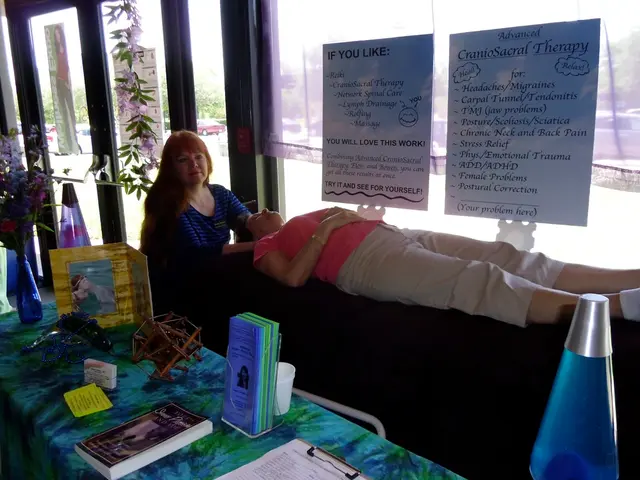Back heat sensation: Identifying symptoms, potential causes, and suitable treatments explained.
A hot back, accompanied by symptoms such as burning pain, numbness, tingling, or fever, can be a sign of various health conditions. This article aims to shed light on the common causes, symptoms, and treatments for such a condition.
One of the most common causes is muscle micro-tears and inflammation from physical exertion or training. These micro-tears cause soreness and inflammation, resulting in pain and a sensation of heat or burning in the back muscles. This typically occurs after overexertion, especially if the person is not well-prepared for the activity.
Sunburn or heat-related skin injury is another potential cause. A hot back with burning pain and redness may result from sunburn. First-degree sunburn affects the outer skin layer, causing redness, pain, and possibly swelling, while second-degree burns cause blistering and more severe pain. Fever and systemic symptoms like chills may indicate heat-related illness, which requires medical attention.
Neuropathic conditions such as erythromelalgia can also cause a hot back. This rare disorder causes episodic burning pain, redness, and heat in affected areas due to abnormal nerve and microvascular function. It is characterized by hyperexcitability of pain neurons and can cause significant burning sensations and tingling.
Infections or systemic illnesses can also lead to a hot back. Back pain accompanied by fever, chills, or burning during urination may indicate an infection such as a urinary tract infection or spinal infection, which requires prompt medical evaluation and treatment.
Heat-related illness or overheating can cause increased body heat sensation and sweating, potentially exacerbating symptoms in the back.
Treatments vary based on the cause. For muscle micro-tears and inflammation, rest, ice or cold compresses, over-the-counter pain relievers, gentle stretching, and avoiding overexertion until healed are recommended. Sunburn treatment includes cool compresses or ice packs, aloe vera lotions, hydration, and over-the-counter pain medication. Erythromelalgia treatment focuses on avoiding heat triggers and managing symptoms, while infection-related back pain requires immediate medical evaluation and antibiotics or other treatments depending on the infection type. Heat-related symptoms are managed through cooling strategies, hydration, avoiding heat exposure and heavy clothing, modifying diet and activity.
If symptoms persist or worsen, or are accompanied by neurological deficits, severe pain, or systemic symptoms, prompt medical care is important to identify potentially serious underlying causes. Untreated cellulitis can lead to a systemic infection called sepsis. A hot back, especially when sudden and without other symptoms, may be a cause for concern.
In conclusion, a hot back can be a sign of various health conditions, ranging from muscle strain to serious infections. It is essential to seek medical attention if symptoms persist or worsen, or if they are accompanied by fever, chills, or other concerning symptoms. Prompt treatment can improve the outlook for burning pain in the back, but it can be difficult to diagnose the cause based on the hot sensation alone, so it is best to see a doctor if the symptom persists.
- Beyond muscle micro-tears, erythromelalgia, a neuropathic condition, can cause a hot back, characterized by burning pain, redness, and heat in affected areas.
- A hot back could be a symptom of atopic dermatitis, a chronic skin condition that can cause itching, redness, and swelling.
- Kidneystones, a common type of urinary tract stone, can cause sharp, aching pain in the back, often accompanied by fever and chills.
- Cellulitis, a bacterial infection of the skin, can also lead to a hot back, typically accompanied by swelling, redness, and possibly fever.
- Hepatitis, an inflammation of the liver, can cause a hot back, often alongside symptoms such as abdominal pain, fatigue, and jaundice.
- Diabetes, a chronic health condition affecting blood sugar levels, can cause a hot back due to neuropathy, a nerve disorder that can lead to burnings sensations.
- Lung cancer (nsclc) can cause a hot back through metastasis, spreading to the bones and causing back pain that may feel like burning or heat.
- Bipolar disorder, a mental health condition, can also present with symptoms such as depression, mania, and fever.
- Asthma, a chronic respiratory condition, can cause a hot back due to inflammation and tightening of the airways.
- Depression, a mental health disorder, can sometimes present with a persistent sense of internal heat or flush.
- In the realm of science and medical-conditions, chronic diseases such as cancer, diabetes, and asthma often require ongoing management and care to mitigate symptoms like a hot back.
- Health and wellness are significant factors in preventing and managing conditions that can cause a hot back, highlighting the importance of fitness and exercise, nutrition, skin care, and mental health.
- CBD, a compound found in cannabis, has been explored for its potential in managing neurological disorders, including chronic pain and neuropathy, which can cause a hot back.
- Early detection and treatment are crucial for predicting the outcome of conditions causing a hot back, reiterating the importance of regular medical check-ups and seeking prompt medical attention when needed.




